At first glance, Advanced Human Performance in Suwanee, Georgia, looks like a standard high-performance gym: all free weights and squat racks and turf. But then you look around.
In one corner, Tampa Bay Rays outfielder Austin Meadows bends forward while balancing on his right foot, moving in slow motion to stabilize a barbell held near his chest. At the other end of the 10,000-square-foot facility, Minnesota Vikings running back Ameer Abdullah holds a bar with three Olympic plates bobbing from elastic bands at his shoulders, squats down slightly, then stands quickly.
None of this (or anything else going on in the gym, really) looks like how you’re taught to train. But the gym’s cofounder Joel Seedman, Ph.D., C.S.C.S., wants you rethinking your training anyway. Since 2006, he’s promoted a unique fitness approach called eccentric isometrics, a style of training that has the potential to save your joints while still letting you build the muscle and strength you want. That’s an attractive proposition to many of the pro athletes who walk into AHP, although Seedman’s ideas do occasionally irritate the training community.
His methods are born of a near-universal fitness paradox: If working out is supposed to make you healthier and stronger, why does it leave you so beat up? Throughout his 20s, Seedman found himself contending with that quandary—battering his body with heavy squats, bench presses, and deadlifts—and struggling with joint inflammation after each session. “[I got] sick of hitting my head against the wall,” he says. “I didn’t care what it looked like, and I didn’t care if everyone in the fitness industry thought I was nuts. I had to figure it out.”
I didn’t care if everyone in the fitness industry thought I was nuts.
So he developed a distinctive take on range of motion. Most trainers tell you to use a muscle’s full range of motion (at least sometimes). Imagine a bench press. They might instruct you to lower the barbell until it touches your chest, then press up. Seedman’s version: Lower any weight only until your joints (in the case of a bench press, your elbows and shoulders) form 90 degree angles. This means stopping your bench press reps much earlier than normal and stopping your chinups well before your chin has reached the bar.
“When you look at muscle physiology, 90 degrees is optimal,” he says. “That’s where the muscle produces the most force.” He points to world-class powerlifters, who often favor box squats, which have you lowering only until your butt touches a box, then firing back to standing. “They’ve adapted their training to incorporate 90 degree mechanics as a means of avoiding injury,” he says.
Seedman toys with other ideas, too, lifting barbells with plates only on one side or doing exercises while balancing on foam rollers. But his commitment to eccentric isometrics is the focus of all his training. It’s actually a blend of two ideas, one that defies training convention and one that’s more traditional. Eccentric refers to the movement in a lift when the muscle is lengthened (think the lowering phase of a curl), and isometric means you’re holding a muscle contraction (think wall squats). Each set winds up being incredibly fatiguing, says Seedman, no matter the weight you use. “[It works] regardless of whether you’re using a light weight or heavy weight,” he says,“because you’re squeezing, staying tight, and everything’s firing.”
Seedman layers challenging twists onto his simple principle, having some athletes (like Abdullah) battle the instability of weights hanging from resistance bands. These variations are Instagram gold, but some critics bristle, insisting he’s on shaky scientific ground. One 2014 study, for example, had participants squatting to either 50 degrees or 90 degrees during eight-week leg programs. The group that squatted deeper built more strength. “He could be a really shitty evidence-based practitioner,” physical therapist and trainer Sam Spinelli, D.P.T., C.S.C.S., says of Seedman. “Or he may be doing this to generate more traffic and sell more books.”
Seedman remains undeterred. “I’ve yet to see a sound scientific rationale against the methods that I pose,” he says. He’s right, too. At worst, his 90-degree-joint-angle theory will lead you to build strength and muscle gradually while alleviating joint wear and tear.
https://www.instagram.com/p/CK6dmiFD2bi/
A post shared by Joel Seedman (@dr.joelseedman_ahp)
The other key to eccentric isometrics isn’t at all outlandish. Seedman wants you to explosively lift each weight and pause at a 90 degree joint angle for two to three seconds, sustaining what’s called an isometric contraction. Then you lower for two to three seconds. Seedman is adamant about this lifting pace, claiming it lets your muscles function like a sling-shot. “Descending slowly is something we all should do more,” says MH fitness director Ebenezer Samuel, C.S.C.S.“There’s nothing at all wrong with this tempo.” For all the controversy around Seedman, many of his moves can get you stronger in a safe way. Here are five you should integrate into your training.
Seedman Specials: Eccentric Isometrics
Learn Seedman’s preferred slow tempo and get a pump, all while protecting your joints from injury.
90 Degree Eccentric Isometric Dumbbell Press
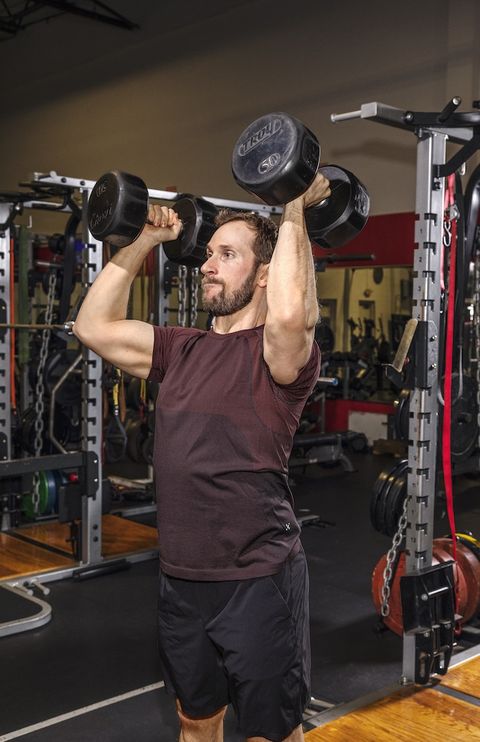
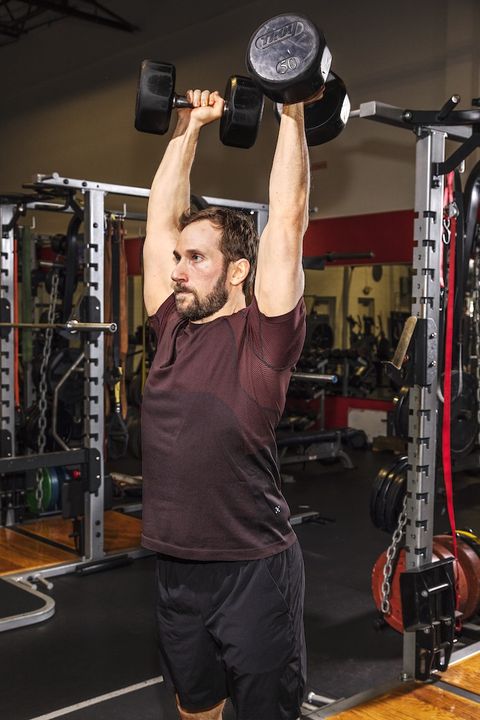
Grab dumbbells you could press 10 times. Press the weights explosively overhead. Lower the dumbbells until your elbows form roughly 90 degree angles. (As with all of the moves, “you’ll feel the natural stopping point,” says Seedman.) Pause 2 seconds, then press overhead explosively. That’s 1 rep; do 3 sets of 5.
Eccentric Isometric Romanian Deadlift

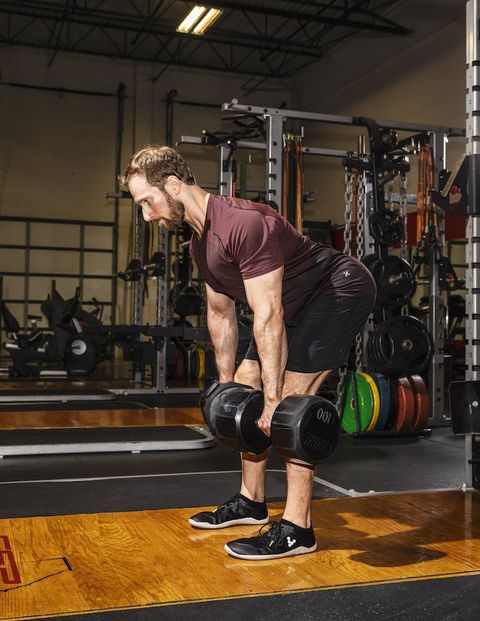
Stand holding heavy dumbbells at your sides, core tight. Keeping your back flat, slowly hinge forward at your hips until you feel a deep stretch in your hamstrings. Hold the stretched position for a 2-count. Keeping your back flat, hinge upward, returning to the starting position and squeezing your glutes. Repeat for 3 to 5 reps. Do 3 sets.
Eccentric Isometric Bird-Dog Row
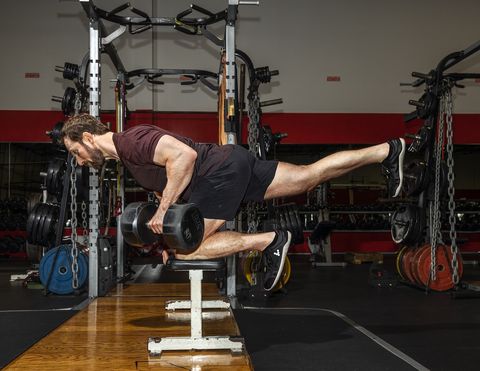
Assume an all-fours position on a bench, a dumbbell in your left hand, right leg extended behind you, parallel to the floor. Let the dumbbell hang down next to the bench. This is the start; hold for 10 seconds. Keeping your torso and extended leg rigid, pull the dumbbell quickly upward as high as possible. Hold 2 seconds.Slowly reverse the movement.Do 3 to 5 reps, then repeat on the other side. Do 3 sets.
Overcoming Isometrics
Start with a tough isometric contraction that primes your body to move weight explosively. Follow it with some fast reps.
Overcoming Isometric Row
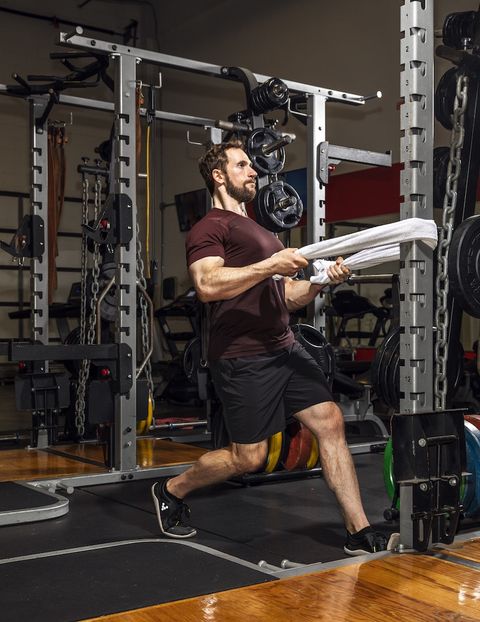
Wrap a towel around the middle of a sturdy dowel or metal bar. Grab the towel with an over-hand grip. Pull your chest hard toward the bar and hold for a 10-count. Directly after, perform 5 row reps (barbell, dumbbell, or cable), being as explosive as possible on each rep. Do 3 sets.
Overcoming Isometric Curl

Wrap a towel under a low bar. Grasp both ends with an underhand grip. Pull upward as hard as possible (as if doing a biceps curl), and hold for 10 seconds. Directly after, do 6 dumbbell curls, being as explosive as possible on each rep. Do 3 sets.
Source: Read Full Article
